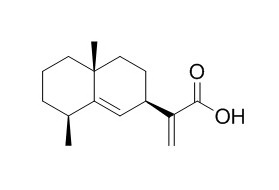Pterodontic acid
Pterodontic acid and pterodondiol showed moderate activity against bacteria including Staphylococcus aureus, Pseudomonas aeruginosa, Bacillus subtilis.
Inquire / Order:
manager@chemfaces.com
Technical Inquiries:
service@chemfaces.com
Tel:
+86-27-84237783
Fax:
+86-27-84254680
Address:
1 Building, No. 83, CheCheng Rd., Wuhan Economic and Technological Development Zone, Wuhan, Hubei 430056, PRC
Providing storage is as stated on the product vial and the vial is kept tightly sealed, the product can be stored for up to
24 months(2-8C).
Wherever possible, you should prepare and use solutions on the same day. However, if you need to make up stock solutions in advance, we recommend that you store the solution as aliquots in tightly sealed vials at -20C. Generally, these will be useable for up to two weeks. Before use, and prior to opening the vial we recommend that you allow your product to equilibrate to room temperature for at least 1 hour.
Need more advice on solubility, usage and handling? Please email to: service@chemfaces.com
The packaging of the product may have turned upside down during transportation, resulting in the natural compounds adhering to the neck or cap of the vial. take the vial out of its packaging and gently shake to let the compounds fall to the bottom of the vial. for liquid products, centrifuge at 200-500 RPM to gather the liquid at the bottom of the vial. try to avoid loss or contamination during handling.
J Microbiol Biotechnol.2020, 30(2):178-186.
Genes (Basel).2021, 12(7):1024.
Food Chem Toxicol.2023, 176:113785.
Revista Brasileira de Farmacognosia2024, 34:1276-1286.
Biochem Biophys Rep.2024, 40:101830.
Cell Physiol Biochem.2019, 52(6):1255-1266
J Agric Food Chem.2021, 69(46):14037-14047.
FASEB J.2019, 33(2):2026-2036
Molecules.2024, 29(5):1171.
GxABT2022, 2268.2:15515.
Related and Featured Products
Yao Xue Xue Bao. 2007 May;42(5):511-5.
Terpenoids and flavonoids from Laggera pterodonta.[Pubmed:
17703774]
METHODS AND RESULTS:
To study the chemical constituents of aerial parts of Laggera pterodonta (DC.) Benth., the air-dried aerial parts of this plant were powered and extracted with boiling water and purified by silica gel column chromatography and recrystallized. Eleven compounds were obtained from L. pterodonta. They were identified as to be 6-O-beta-D-glucopyranosyl-carvotanacetone (1), Pterodontic acid (2), 1beta-hydroxy pterondontic acid (3), pterodontoside A (4), pterodondiol (5), pterodontriol B (6), 5-hydroxy-3,4', 6,7-tetramethoxyflavone (7), artemitin (8), chrysosplenetin B (9), quercetin (10) and beta-sitosterol (11). Compound 1 is a new monoterpene glucoside. Compounds 10 and 11 were isolated from this plant for the first time.
CONCLUSIONS:
Compounds 2 and 5 showed moderate activity against bacteria including Staphylococcus aureus, Pseudomonas aeruginosa, Bacillus subtilis, Mycobacteium phlei and Bacillus circulans by paper disc diffusion method, while they both displayed no activity against Escherichia coli.



